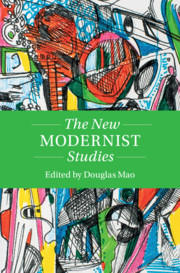Book contents
- The New Modernist Studies
- Twenty-First-Century Critical Revisions
- The New Modernist Studies
- Copyright page
- Dedication
- Contents
- Figures
- Notes on Contributors
- Acknowledgments
- Introduction
- I Histories
- II Horizons
- Chapter 3 Planetarity’s Edges
- Chapter 4 Religion’s Configurations
- Chapter 5 Disability’s Disruptions
- Chapter 6 Affect’s Vocabularies
- Chapter 7 Invisibility’s Arts
- Chapter 8 Black Writing’s Visuals
- Chapter 9 Noir Film’s Soundtracks
- Chapter 10 Language’s Hopes
- Chapter 11 Revolution’s Demands
- Chapter 12 Feminism’s Archives
- Chapter 13 Risk’s Instruments
- Chapter 14 Deep Time’s Hauntings
- Bibliography
- Index
Chapter 6 - Affect’s Vocabularies
Literature and Feeling after 1890
from II - Horizons
Published online by Cambridge University Press: 21 January 2021
- The New Modernist Studies
- Twenty-First-Century Critical Revisions
- The New Modernist Studies
- Copyright page
- Dedication
- Contents
- Figures
- Notes on Contributors
- Acknowledgments
- Introduction
- I Histories
- II Horizons
- Chapter 3 Planetarity’s Edges
- Chapter 4 Religion’s Configurations
- Chapter 5 Disability’s Disruptions
- Chapter 6 Affect’s Vocabularies
- Chapter 7 Invisibility’s Arts
- Chapter 8 Black Writing’s Visuals
- Chapter 9 Noir Film’s Soundtracks
- Chapter 10 Language’s Hopes
- Chapter 11 Revolution’s Demands
- Chapter 12 Feminism’s Archives
- Chapter 13 Risk’s Instruments
- Chapter 14 Deep Time’s Hauntings
- Bibliography
- Index
Summary
Affective states and their representational forms have been as crucial to critical constructions of modernism as to the writing we associate with its multiple movements, moments, and legacies. At the confluence of represented feeling and registrations of affect, ambitions of otherwise historically distinct writers come into conversation. To see how this conversation might enhance modernist studies’ critical-affective literacies, this chapter follows a transhistorical rather than a discretely periodized arc, gauging the conceptual challenges and interpretive opportunities that come with close reading affective representation as it interlaces modernism’s stylistic aspirations and political valences. It considers how changing disciplinary priorities are transforming the ways in which modernist studies addresses affect’s critical purchase. And it encompasses both early twentieth- and twenty-first-century figures (Virginia Woolf, Wyndham Lewis, Storm Jameson, Ian McEwan, and Rachael Cusk) to explore analytical synergies between vocabularies of feeling and evolving strategies of experimental form.
- Type
- Chapter
- Information
- The New Modernist Studies , pp. 129 - 151Publisher: Cambridge University PressPrint publication year: 2021

